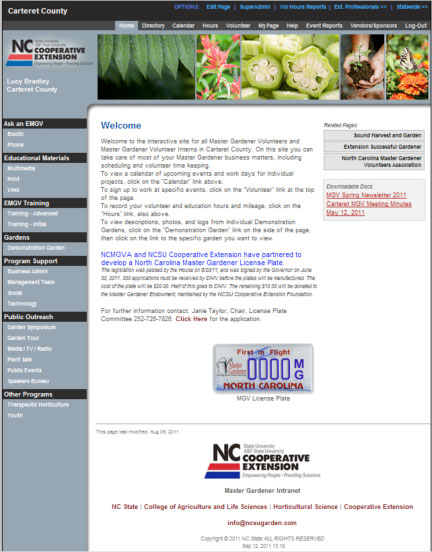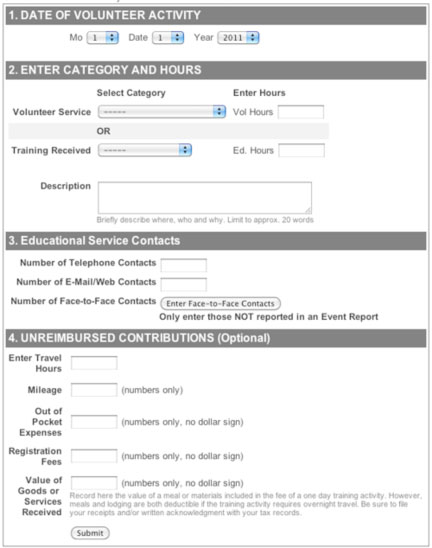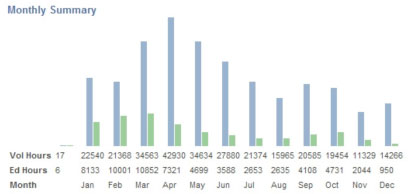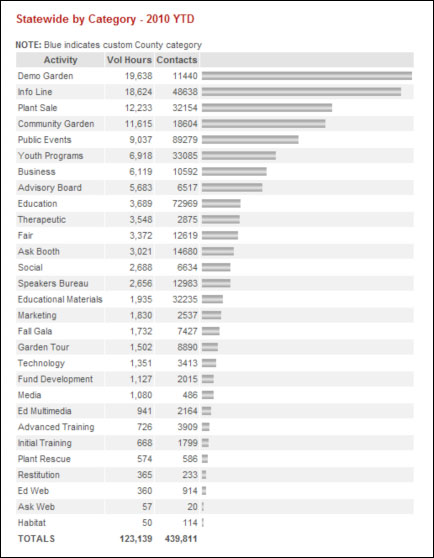 |
December 2011
|
December 2011 // Volume 49 // Number 6 // Tools of the Trade // v49-6tt5
Extension Master Gardener Intranet: Automating Administration, Motivating Volunteers, Increasing Efficiency, and Facilitating Impact Reporting
Abstract
North Carolina State University has incorporated many aspects of volunteer program administration and reporting into an on-line solution that integrates impact reporting into daily program management. The Extension Master Gardener Intranet automates many of the administrative tasks associated with volunteer management, increasing efficiency, and facilitating impact reporting while inherently motivating volunteers by meeting their needs for achievement, affiliation, and power.
Introduction
You can manage the most productive, inspiring, and impactful program on the planet but without accurate reporting, recognition, funding, and support may be elusive. However, the expenditure of time and effort required for "enhanced accountability" (Franz & McCann, 2007) can take on a life of its own, seeming less like an investment in your program's future and more like a career change. This is problematic because the goal of reporting is not to have more to do, but to allow you to do more. The dream, then, is to truly integrate impact reporting while streamlining administration, with a system that also engages, inspires, and empowers volunteers (Culp, 2009).
To this end, NC State University launched an online volunteer management and empowerment Intranet designed to enhance communication, promote volunteering, support networking, and facilitate reporting (Figure 1). The Extension Master Gardener Volunteer Intranet (EMGVI) is divided into three main components that share a common framework: a customizable site for each of the 100 counties; a statewide site for all volunteers and staff; and an Extension professional site for staff only. The data gathered in the counties can be aggregated at the district and state level. The system was developed on Apache/MySQL/PHP (AMP) Web server environment. For more information see<http://www.ncsugarden.com/overview.php>.
Figure 1.
Sample EMGVI County Home Page, Carteret County

Automating Administration
At its core, the EMGVI is designed to do the heavy lifting of administrative paperwork for over 4,000 volunteers. The EMGVI hosts four levels of participation. Master Gardeners are automatically granted Level 1 status. The county agent is assigned Level 3 status and can change the status of anyone in his or her county to any of the first three levels (Table 1).
| Level 1: Volunteer Master Gardeners | Level 2: Page Administrators | Level 3: County Administrators | Level 4: Webmaster | |
| View Home County site | ✓ | ✓ | ✓ | ✓ |
| Log and track personal education and volunteer hours | ✓ | ✓ | ✓ | ✓ |
| Register and withdraw from volunteer opportunities | ✓ | ✓ | ✓ | ✓ |
| Manage personal contact and profile information | ✓ | ✓ | ✓ | ✓ |
| Add and remove content on Home County site | ✓ | ✓ | ✓ | |
| Manage online volunteers, projects, events and programs | ✓ | ✓ | ||
| Change County site navigation | ✓ | ✓ | ||
| Manage other people's data | ✓ | ✓ | ||
| Create and manage schedules | ✓ | ✓ | ||
| Generate reports | ✓ | ✓ | ||
| Use broadcast email function | ✓ | ✓ | ||
| Super Admin authority in every county | ✓ | |||
| Other website management tools | ✓ |
By promoting a volunteer or paid staff to levels 2 and 3, the county horticulture agent is able to delegate tasks and gain help with administration.
Motivating Volunteers
Volunteers manage their own contact information, personal profile, and images, and log their volunteer service and educational hours on-line. They have 24/7 instant access to program information and can register (or un-register) for volunteer opportunities with the click of a button. The EMGVI has incorporated a variety of strategies identified in previous research as effective motivators for Extension Master Gardener Volunteers (EMGVs). (Schrock, Meyer, Ascher & Snyder, 2000; Rohs & Westerfield, 1998; Stouse & Marr, 1992) In addition, the program is structured to inherently motivate volunteers by meeting their needs for achievement, affiliation and power (McClelland, 1987).
Achievement
Opportunity to increase knowledge and skills is the top motivation reported by EMGVs (Schrock, Meyer, Ascher & Snyder, 2000). County and State educational opportunities are available on the calendar, program pages, newsletters, PowerPoints, publications and links.
- Using the site enhances comfort with the Web and enhances overall web skills.
- Program pages clearly identify how EMGVs are advancing society and contributing to community growth and development.
- Master Gardeners can view their hours and in-kind donations, and can compare individual and county standings.
- Volunteers can easily view all upcoming volunteer opportunities and select options that match their personal goals and abilities.
- Successes are celebrated throughout the site.
Affiliation
- The Directory and "My Page" provide easy access to self-selected images, contact information, bio, and committee participation helping Master Gardeners build relationships based on shared interests, proximity, and other factors.
- Program Content pages promote a better understanding of the breadth of the program, instilling pride and a better understanding of all the opportunities available.
- Online scheduling allows volunteers to see who will be working when and where, facilitating carpooling and allowing individuals to choose with whom they will work.
Power
- Embedded in the EMGVI is a virtual community promoting leadership through universal access to information and opportunities. This encourages participation even from those who aren't available to attend meetings or visit the extension office on a regular basis.
- Agents are able to delegate specific tasks, key sections of the program, or the entire county site, providing graduated levels of participation and status.
- Information is provided at each volunteer's own pace and schedule.
- Clear guidelines encourage independence while promoting success.
- Volunteers choose how they want to contribute.
Increasing Efficiency
The EMGVI brings the entire program together under one comprehensive Web umbrella. Agents can easily share PowerPoints, images, and other resources with each other and with EMGVs, minimizing duplication of effort and giving new agents immediate access to useful tools. They can send broadcast emails to all their EMGVs or select a subgroup based on committee or status. Forms and data collection are standardized across the state. Agents can review and accept or decline statewide and national events for inclusion in their own county's Extension Master Gardener calendar. The agent can capture in full the value of the volunteer work done in his or her county without needing dozens of staff support hours to pull the information together. Everything is in one place, easy to find, accurate, and up to date.
Facilitating Impact Reporting
All of this empowerment takes the form of a lot of data (Figure 2), which can easily be viewed in a variety of useful ways (Figures 3, 4, 5). The information is available on an individual volunteer, county, and statewide basis. The benefit of having one consistent data collection site increases at a level of magnitude as the reporting moves up the ladder from the individual volunteer, to the county program, to statewide reporting needs.
Figure 2.
Volunteer Hour Reporting Form

Figure 3.
Volunteer Hours by County, Leader Board

Figure 4.
Volunteer Hours by Month, Statewide

Figure 5.
Volunteer Hours by Category, Statewide

At the individual level, this information is used for tax records and to determine awards for annual volunteer recognition. On the County level, reports with the breakdown of volunteer and education hours, travel time, and expenses, along with event reports that identify the audience reached, give a bigger picture of efforts at a program level. Finally, aggregated data from all counties is assimilated into a variety of reports to stakeholders, grantors, and University staff. The end result is reporting that is becoming more robust as the site evolves.
Conclusion
Using an automated system to manage many of the administrative tasks related to the Extension Master Gardener Volunteer Program has many benefits, including: automating administration, motivating volunteers, increasing efficiency, and facilitating impact reporting.
Acknowledgements
The authors wish to express our appreciation to Anne Edwards, and Linda Brandon for their assistance in preparing this article.
References
Culp, K. (2009). Recruiting and engaging baby boomer volunteers. Journal of Extension [On-line], 47(2) Article 2RIB2. Available at: http://www.joe.org/joe/2009april/rb2.php
Franz, N., & McCann, M. (2007). Reporting program impacts: slaying the dragon of resistance. Journal of Extension [On-line], 45(6) Article 6TOT1. Available at: http://www.joe.org/joe/2007december/tt1.php
McClelland, D. C. (1987). Human motivation. New York, New York: Cambridge University Press.
Rohs, F. R., & Westerfield, R. R. (1996). Factors influencing volunteering in the Master Gardener program. HortTechnology, 6(3): 281-285. Retrieved from: http://horttech.ashspublications.org/cgi/reprint/ 6/3/281?maxtoshow=&hits=10&RESULTFORMAT=&author1=Rohs&searchid=1&FIRSTINDEX=0&sortspec=relevance& volume=6&resourcetype=HWCIT
Schrock, D. S., Meyer, M., Ascher, P., & Snyder, M. (2000). Benefits and values of the Master Gardener program. Journal of Extension [On-line], 38(1) Article 1RIB2. Available at: http://www.joe.org/joe/2000february/rb2.php
Stouse, L., & Marr. C. (1992). Retaining Master Gardener volunteers. HortTechnology. 2(2) p244-245 Retrieved from: http://horttech.ashspublications.org/cgi/reprint/ 2/2/244?maxtoshow=&hits=10&RESULTFORMAT=&author1=Stouse&searchid=1&FIRSTINDEX=0&sortspec=relevance& resourcetype=HWCIT




